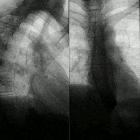nephrogenic systemic fibrosis
Nephrogenic systemic fibrosis (NSF), also known as nephrogenic fibrosing dermopathy, is a complication of gadolinium-based contrast agents used in MRI.
It is characterized by "firm, erythematous, and indurated plaques of the skin associated with subcutaneous edema" . Eventually, flexure contractures develop, with restriction to movement, pain and pruritus. Although the skin is primarily involved, many other organs (e.g. lungs, heart, diaphragm, liver, kidneys, esophagus, and skeletal muscles) can also be involved, eventually leading to death .
Application of preventive guidelines on usage of gadolinium based contrast agents in patients with reduced renal function has been shown to be extremely effective in protection of patient from NSF.
Screening
Patients should be screened for the possible risk of developing NSF by using institutional screening questionnaires and calculating the eGFR :
- history of renal disease: renal transplant (20% develop NSF), dialysis, single kidney, renal malignancy, renal surgery; should have eGFR checked
- liver failure patients: should have eGFR checked
- hypertension requiring medication
- diabetes mellitus
- outpatient screening (not on dialysis): eGFR use is controversial as they rarely develop NSF
Recommendations
Avoid gadolinium-containing contrast agents in patients whose:
- eGFR is <30 mL/min/1.73 m
Cautionary use of gadolinium-containing contrast agents in patients whose :
- eGFR is <60 mL/min/1.73 m
"When contrast-enhanced MR imaging is requested for a patient with renal insufficiency who is hospitalized due to major surgery, major infection, or a thrombotic vascular event, alternative imaging is indicated to avoid the use of gadolinium-based contrast agents; this decision should be made after consultation with the referring service and the patient" .
In cases where contrast still needs to be given :
- if eGFR <30 mL/min
- take informed consent (risk of NSF <1/10,000 patients with eGFR <30 mL/min)
- the maximum dose of 0.1 mmol/kg
- adequate hydration must be provided
- if the patient is on dialysis: (inpatient)
- MRI should be done just before dialysis as the contrast can be removed by subsequent dialysis
- some centers consider dialysis a strict contraindication
Clinical presentation
- typically presents weeks to months after the administration of Gd
- typically involves the dermis in the extremities symmetrically, less commonly the trunk with the face spared, typically sparing the antecubital and popliteal fossae
- presentation resembles scleromyxedema or eosinophilic fasciitis
- skin lesions: hyperpigmented, thickened brawny induration
- joint contractures
- pain, pruritus, skin tightness or burning sensation
Pathology
The development of NSF with exposure to gadolinium-containing MRI contrast agents has been strongly reported in patients with moderate to end-stage renal impairment. This could be due to transmetallation, which is the replacement of the gadolinium from the chelate and forming a free gadolinium ion, free gadolinium ions may then deposit in different tissues and result in inflammation and fibrosis. Prolonged clearance times of gadolinium-based contrast agents in significant renal insufficiency contributes to this transmetallation process . Low stability gadolinium contrast media show the strongest association with NSF.
Additional positive risk factors include:
- concurrent infectious/inflammatory condition
- concurrent infarcted/ischemic tissue (e.g. peripheral arterial thromboembolism)
- recent surgery/trauma
Histology
- deep dermal biopsy required
- however findings are non-specific: thickened collagen bundle, mucin deposition, spindle cell proliferation, CD3 + fibroblasts
Contrast agents
The medical literature review has shown that ~78% of all unconfounded, single-agent cases of NSF have been associated with Omniscan (gadodiamide), while ~20% have been associated with Magnevist (gadopentetate dimeglumine), and less than 2%, with OptiMARK (gadoversetamide) .
Radiographic features
- diffuse soft tissue tracer uptake on bone scans
- skin thickening and subcutaneous stranding on multiple modalities
- skin and muscle activity on PET
Treatment and prognosis
- no consistently effective therapy
- improved renal function: renal transplant, recovery from acute renal failure (ARF)
- physical therapy
- extracorporeal photopheresis, plasmapheresis, immunoglobulin therapy, steroids and other immunosuppressive agents
Siehe auch:
und weiter:

 Assoziationen und Differentialdiagnosen zu Gd NSF:
Assoziationen und Differentialdiagnosen zu Gd NSF:
